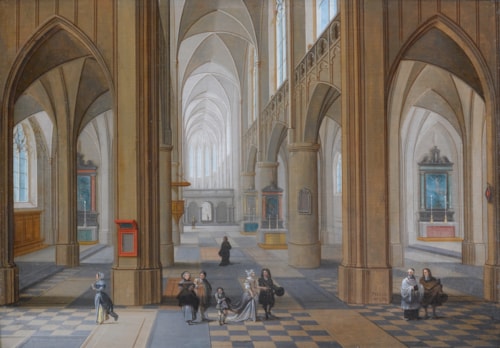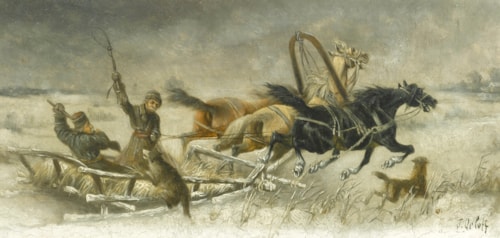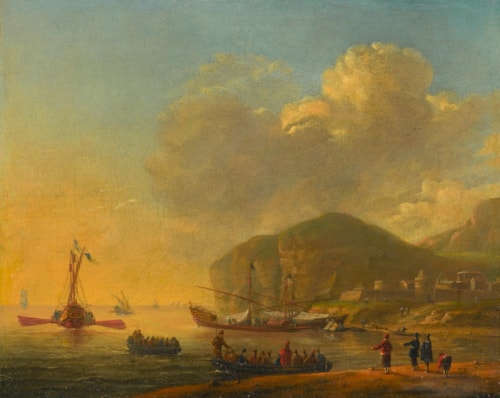eodor Karlovich Burhardt
(St. Petersburg 1854 - 1918)
A Winter Landscape with a Troika on a Track
signed in Cyrillic and dated ‘1903’ (lower right)
oil on canvas
38 x 47 cm
A solitary troika makes its way slowly through a desolate winter landscape. The expanse of white snow in the foreground stands in contrast to the dark and stormy sky. The wintry trees are mostly bare, and behind them is a dark mass of woodland. Some of the trees’ branches are highlighted by the snow that has settled upon them, causing them to stand out from the shadowy block painted behind them. The forbidding dark of the sky mirrors the tones of the woodland, and the softer more blended touches of paint in the sky give a sense of the infinite. There is a distinct sense of stillness, quiet and isolation to the work, emphasised by the inclusion of the lone troika in the distance.
Documenting the changing nature of the Russian landscape throughout the year was one of the major themes in Feodor Karlovich Burhardt’s work, a further example being Spring Landscape. (Private Collection) Neither work can be described as an idealised representation of the Russian landscape. Burhardt’s vision of winter is an inhospitable one, and in Spring Landscape the countryside is dank, almost marsh like, in contrast to the more traditional, optimistic associations of that season. Although rural dwellings are clearly visible in Spring Landscape none of their residents are, and the relative lack of human presence in both works focuses the viewer’s attention on Burhardt’s skilled depiction of nature, and creates a sense of remote isolation. The works reflect the realities of rural life in Russia, without exaggerating either the positives or negatives of the conditions of these vast and remote landscapes.
Born in St. Petersburg, Burhardt worked throughout the latter half of the nineteenth, and into the early twentieth century, part if the great age of Russian landscape painting. Although he also painted still lives, he predominantly worked as a landscape painter, and was part of the same circle of artists as Isaac Illyich Levitan (1860–1900). He exhibited throughout his career in both Moscow and St. Petersburg and his work was widely reproduced in both magazines and postcards. A Winter Landscape with a Troika on a Track is a fine example of his work, testament to both his technical skill and his ability to imbibe his landscapes with a distinctive mood.
A solitary troika makes its way slowly through a desolate winter landscape. The expanse of white snow in the foreground stands in contrast to the dark and stormy sky. The wintry trees are mostly bare, and behind them is a dark mass of woodland. Some of the trees’ branches are highlighted by the snow that has settled upon them, causing them to stand out from the shadowy block painted behind them. The forbidding dark of the sky mirrors the tones of the woodland, and the softer more blended touches of paint in the sky give a sense of the infinite. There is a distinct sense of stillness, quiet and isolation to the work, emphasised by the inclusion of the lone troika in the distance.
Documenting the changing nature of the Russian landscape throughout the year was one of the major themes in Feodor Karlovich Burhardt’s work, a further example being Spring Landscape. (Private Collection) Neither work can be described as an idealised representation of the Russian landscape. Burhardt’s vision of winter is an inhospitable one, and in Spring Landscape the countryside is dank, almost marsh like, in contrast to the more traditional, optimistic associations of that season. Although rural dwellings are clearly visible in Spring Landscape none of their residents are, and the relative lack of human presence in both works focuses the viewer’s attention on Burhardt’s skilled depiction of nature, and creates a sense of remote isolation. The works reflect the realities of rural life in Russia, without exaggerating either the positives or negatives of the conditions of these vast and remote landscapes.
Born in St. Petersburg, Burhardt worked throughout the latter half of the nineteenth, and into the early twentieth century, part if the great age of Russian landscape painting. Although he also painted still lives, he predominantly worked as a landscape painter, and was part of the same circle of artists as Isaac Illyich Levitan (1860–1900). He exhibited throughout his career in both Moscow and St. Petersburg and his work was widely reproduced in both magazines and postcards. A Winter Landscape with a Troika on a Track is a fine example of his work, testament to both his technical skill and his ability to imbibe his landscapes with a distinctive mood.





 contact
contact contact
contact +44 20 7313 8040
+44 20 7313 8040









